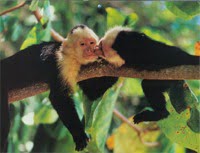Why are pair-bonding tamarins and humans different from chimps?
 The Lazy Way to Stay in Love pointed out that humans are pair bonders, with the unique ability to strengthen their romantic bonds at will. We do so by employing a special range of subconscious signals, or “bonding behaviors”
The Lazy Way to Stay in Love pointed out that humans are pair bonders, with the unique ability to strengthen their romantic bonds at will. We do so by employing a special range of subconscious signals, or “bonding behaviors”
These behaviors (technically, attachment cues) include skin-to-skin contact, sensual kissing, gentle stroking, wordless sounds of contentment and pleasure, hugging or silent spooning, smiling with eye contact, caressing of breasts, penis holding, playful intimacy, relaxed intercourse, and so forth. Used daily, they effortlessly increase relationship satisfaction because they bypass the yakety-yak of our cerebral cortex and make a beeline for our limbic brain. In contrast, talk is cheap. Not only that, it gets filtered through the brain’s analytical centers where we tend to add all sorts of spin to what we hear. Said one woman who experimented with daily bonding behaviors:
Those delicious warm melting tingly feelings (that make you go mmmm, ahhh, and ohhhh) that used to take a while to turn on (through kissing, caressing, sex), are now just there waiting, and don’t need any time at all to awaken again. My breasts, ears and inner wrists are now like ‘off pause’ buttons.
Like all animals, humans are primed to perceive the signals that indicate whether or not another is safe enough to relax with. If these safety signals are not forthcoming, a subtle defensiveness creates emotional distance. This can happen even if there was lots of lovin’ in the past. Bonding behaviors deliver the safe-to-bond message by relaxing the defensive mechanism of the brain (primarily the amygdala), but they need to occur frequently.
One reason that these affectionate acts increase the urge to merge with a mate is that they induce the flow of oxytocin (the “cuddle hormone”). Oxytocin lowers anxiety, increases trust, and counteracts depression. In short, we feel good interacting with this person; it’s rewarding at a neurochemical, or subconscious, level. Not surprisingly, earlier this year scientists reported that those in committed relationships produce less stress-related cortisol. Mated humans also live longer, and have lower rates of psychological distress. There’s even growing evidence that oxytocin (or oxytocin-producing behaviors) may prove to be effective protection against addiction in pair bonders. (Alas, pair bonders may be more prone to addiction than other mammals, due to the very brain sensitivity that makes pair bonding possible.) For us, teaming up is good medicine.
Recent research on tamarin monkeys confirms the power of simple behaviors of this type to release soothing oxytocin and keep monkey-love alive. Tamarins, like humans, are socially monogamous pair bonders that raise their young together.
In contrast, chimps and bonobos do not form pair bonds. They haven’t evolved the neural machinery for it. Keep in mind that, although chimps may be our closest living genetic relatives, our paths forked about six million years ago. Our true closest genetic relatives were located on our branch even if they’re no longer around. Somewhere along our branch we evolved into pair bonders, as have tamarins, gibbons and titi monkeys. Sex is rewarding for all mammals, but for pair bonders, contact with a particular mate can also register as very rewarding. (For more on the neural mechanics of pair bonding, see the remarks of Larry Young at the end of this article.)
The point is that we’re part of a small club of primate species wired for the ability to fall in love and settle in with one significant other, whether or not we choose to avail ourselves of this option. We’re not programmed to be “sexually monogamous.” No species is. But we are “socially monogamous,” that is, able to pair up. The fact that we sometimes experience lust in the absence of attachment doesn’t make us bonobos, or mean we’d be happier with a more casual approach to mating.
Monkey-love detective
 Aware of the link between attachment behaviors and oxytocin, University of Wisconsin researcher Chuck Snowden decided to measure both in tamarin monkey pairs that had been together for at least a year. His results revealed a wide range of oxytocin levels among the pairs. However, within each pair, mates had similar levels. Whatever they were doing clearly benefited both.
Aware of the link between attachment behaviors and oxytocin, University of Wisconsin researcher Chuck Snowden decided to measure both in tamarin monkey pairs that had been together for at least a year. His results revealed a wide range of oxytocin levels among the pairs. However, within each pair, mates had similar levels. Whatever they were doing clearly benefited both.
Here’s the key finding: The pairs with highest oxytocin levels engaged in the most affiliative and sexual behaviors. These behaviors are tamarin versions of bonding behaviors: snuggling up with tails intertwined, grooming, tongue flicking and scent marking/investigation, erections, solicitations (flirting by either sex), investigations of genitals, and all mounts in which the female was receptive, whether or not the mount led to actual copulation—or ejaculation. No performance worries for tamarins!
Tamarins mount almost daily, regardless of where the female is in her cycle, so getting it on is not just about fertilization. In private correspondence about the role of nonconceptive sex in primate pair bonding, Snowden opined, “The physical contact of making love [is] important [and] orgasm is simply a nice and fun add-on when it happens.” (For a recent book that affirms the benefits of this relaxed concept in human intimacy see Tantric Sex for Men.)
The researchers concluded that oxytocin levels probably reflect the quality of a pair bond, and are likely maintained through the behaviors they observed. Said Snowdon, “Here we have a nonhuman primate model that has to solve the same problems that we do: to stay together and maintain a monogamous relationship, to rear children, and oxytocin may be a mechanism they use to maintain the relationship.”
Snowdon’s team suggested that close contact and nonconceptive sexual behavior might also predict the quality and duration of human relationships. Sadly, we humans often overlook the importance of these comforting signals.
How many couples, after the honeymoon frenzy subsides, have occasional sex but rarely engage in affectionate, sexy (but non-goal-oriented) contact? Intermittent orgasms may simply not be enough to keep their oxytocin up or their bonds strong. Occasional sex is like turning a water faucet on…and then off. Daily bonding behaviors are like a steady flow of water that keeps your pipes from freezing. True, some couples attempt to keep their bonds strong with intense sexual stimulation in the belief that frequent orgasms are the best glue. Yet it may be that this narrow focus causes them to overshoot the more easygoing rhythm of pair-bonder romance or, paradoxically, numb their pleasure response.
In The Myth of Monogamy David Barash points out that in pair-bonding mammals sex is not “especially fervent.” (At least not after the initial frenzy.) Many interactions between mates take the form of resting together, mutual grooming, and hanging out.
 The interesting point is that human lovers have a choice. Unlike other mammals, we can consciously enhance the quality and satisfaction of our unions by increasing our mutual oxytocin levels with simple, nearly effortless signals. We simply use our expanded cerebral cortex to jumpstart our brain’s limbic love machinery. Maybe the thirteen percent of couples who maintain juicy bonds somehow stumble upon this secret early in their unions without consciously realizing it.
The interesting point is that human lovers have a choice. Unlike other mammals, we can consciously enhance the quality and satisfaction of our unions by increasing our mutual oxytocin levels with simple, nearly effortless signals. We simply use our expanded cerebral cortex to jumpstart our brain’s limbic love machinery. Maybe the thirteen percent of couples who maintain juicy bonds somehow stumble upon this secret early in their unions without consciously realizing it.
Has romance failed you in the past? Did you offer your fellow pair-bonding mammal enough of the bonding signals to keep your mutual perception of each other rosy, allow you to overlook errors, and deepen the intimacy between you? If not, take a lesson from your pair-bonding primate cousins.
___
[From Speaker Summary of talk by Larry Young, PhD entitled, “Neurobiology of Social Bonding and Monogamy…”]
Prairie voles, like humans, are highly social and form long-lasting pair bonds between mates. This is in contrast to 95 percent of all mammalian species, which do not appear capable of forming long lasting social bonds between mates. Studies examining the brain and genetic mechanisms underlying pair bonding have revealed an important role for a few key chemicals in the brain in establishing social relationships. Oxytocin and vasopressin appear to focus the brain’s attention to the social signals in the environment. During pair bond formation, these chemicals interact with the brain’s reward system (e.g. dopamine) to establish an association between the social cues of the partner and the rewarding nature of mating. So why are some species capable of forming social bonds while others are not? Research comparing the brains of monogamous and non-monogamous species reveals that it is the location of the receptors that respond to oxytocin and vasopressin that determines whether an individual will be capable of bonding. For example, monogamous male prairie voles have high concentrations of vasopressin receptors in a ventral forebrain reward center that is also involved in addiction. Non-monogamous meadow voles lack receptors there. However, if receptors are inserted into this reward center in the non-monogamous meadow vole, these males suddenly develop the capacity to form bonds. These studies also suggest that pair bonding shares many of the same brain mechanisms as addiction. Genetic studies have revealed that DNA sequence variation in the gene encoding the vasopressin receptor affect the level of receptor expression in certain brain regions and predict the probability that the male will form a social bond with a female.
Recent studies in humans have revealed remarkable similarities in the roles of oxytocin and vasopressin in regulating social cognition and behavior in vole and man. Variation in the DNA sequence of the human vasopressin receptor gene has been associated with variation in measures of romantic relationship quality. In humans, intranasal delivery of oxytocin enhances trust, increases gaze to the eyes, increases empathy and enhances socially-reinforced learning. Indeed it appears that stimulating the oxytocin system in humans increases the attention to social cues in the environment….